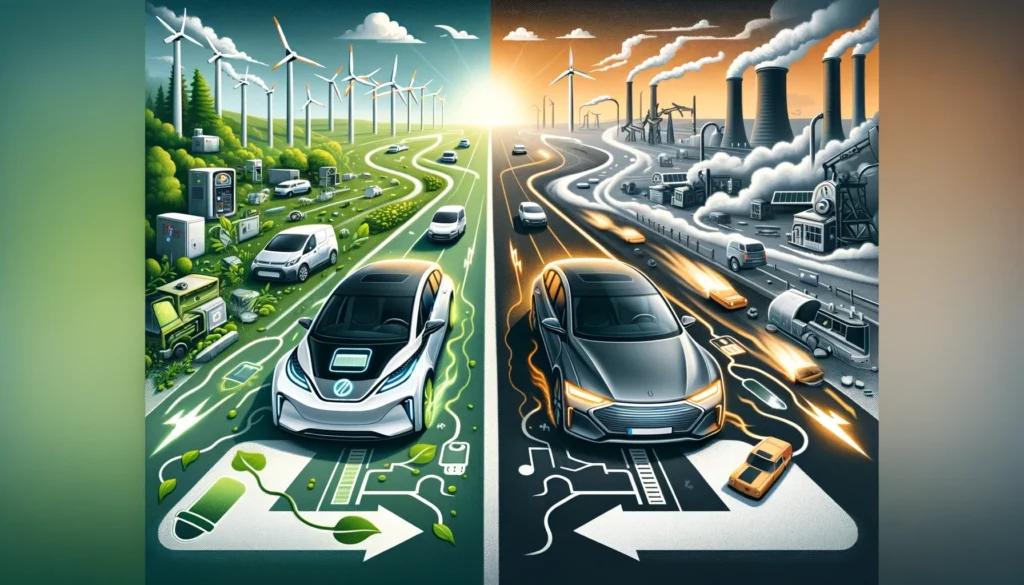In an age where environmental concerns are paramount, electric vehicles (EVs) are emerging as beacons of energy efficiency. A profound analysis reveals that EVs consume approximately half the energy required by gasoline-powered vehicles. This significant disparity is attributed to the fundamental differences in energy utilization between electric and gasoline engines.
EV Engines VS Internal Combustion Engines Efficiency
Electric vehicles (EVs) and Internal Combustion Engine (ICE) vehicles represent two distinct approaches to automotive propulsion, each with its unique characteristics and implications. EVs are propelled by electric motors powered by batteries, which makes them remarkably efficient in converting energy to motion with minimal energy loss, typically around 11%. This efficiency results in lower operating costs and reduced greenhouse gas emissions, especially when charged with renewable energy sources. Additionally, EVs benefit from simpler mechanics with fewer moving parts, leading to lower maintenance requirements. In contrast, ICE vehicles rely on burning fossil fuels, generally less efficient in energy conversion, losing a significant portion of energy as heat, with efficiency usually under 30%. This traditional technology offers a well-established infrastructure for refueling and longer driving ranges, which have been historical advantages over EVs. However, they contribute more significantly to air pollution and are subject to the volatility of fuel prices. The evolution of battery technology and the expansion of charging infrastructure are rapidly addressing the range and convenience concerns of EVs, making them increasingly viable as sustainable alternatives to ICE vehicles.
Coal Power Plants VS Wind, Solar, or Hydropower as EV Power Sources
The energy source powering EVs also plays a critical role in their efficiency. While coal-fired power plants are less efficient, EVs powered by these plants still surpass the energy efficiency of traditional gasoline vehicles. The benefits are magnified when EVs are charged using renewable energy sources like wind, solar, or hydropower. These clean energy sources not only augment the efficiency of EVs but also contribute to a reduction in overall carbon emissions.
Geographical variations in energy sources lead to differences in the efficiency and environmental impact of EVs. Regions powered predominantly by renewable energy will see greater benefits from the adoption of EVs. This highlights the importance of a holistic approach to energy production and consumption, integrating clean energy sources into the grid to maximize the environmental benefits of electric transportation.
Important Factors to Consider When Comparing EV VS ICE Energy Efficiency:
- Energy Efficiency and Cost: In terms of energy efficiency and cost, both EVs and gasoline vehicles have their advantages and drawbacks, which can vary depending on the region. For example, in the northeastern U.S., the cost per kilometer for driving an electric vehicle like the Nissan Leaf and a gasoline-powered vehicle like the Honda Civic is roughly the same. However, these costs can fluctuate based on electricity and gasoline prices, which are influenced by several factors including the source of electricity (fossil fuels, hydro, nuclear, wind, solar) and taxes applied to fuels.
- Environmental Impact: Electric cars generally have a lower environmental impact compared to gas-powered cars, especially if the electricity used to charge them comes from clean energy sources. The impact of EVs on the environment is primarily determined by where they are manufactured and the size of their battery pack, whereas the main environmental impact of gas-powered vehicles occurs during their use. It’s important to note that the production of EV batteries, especially larger ones, can have a significant environmental impact.
- Carbon Emissions: The carbon emissions of EVs compared to gas-powered vehicles can vary greatly depending on the source of electricity. For example, in regions with a clean energy grid, like Washington State, an EV can emit up to 61% less carbon than a hybrid car. However, in areas with a coal-heavy energy mix, like West Virginia, EVs may still emit more carbon than hybrids but less than gasoline cars. Overall, EVs tend to have a lower carbon footprint than gasoline cars.
- Future Trends: As countries continue to add more clean energy to their grids, the environmental benefits of EVs are expected to increase. Advances in technology and increasing efficiency of both EVs and internal combustion engines will also play a role in determining their relative environmental impact in the future.
The transition to EVs is not just an environmental imperative but also an economic one. Reduced energy consumption translates to lower operating costs, making EVs a financially viable option in the long run. Governments and industry stakeholders are increasingly recognizing the potential of EVs, leading to investments in infrastructure and incentives to accelerate their adoption.
Final thoughts
The shift towards electric vehicles is a pivotal step in our journey towards sustainable transportation. By significantly reducing energy consumption and leveraging renewable energy, EVs offer a promising path to a cleaner, more efficient, and environmentally friendly future.


